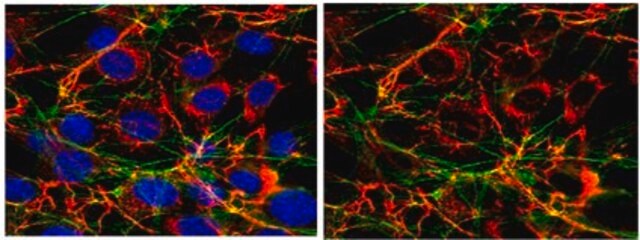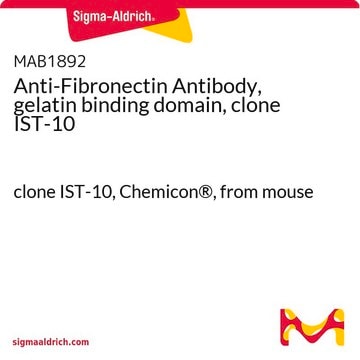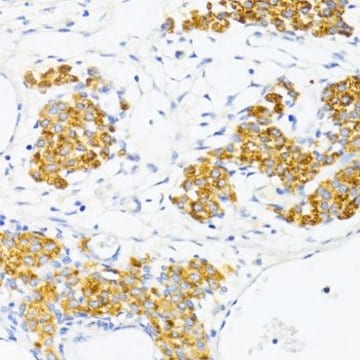F0916
Monoclonal Anti-Fibronectin antibody produced in mouse
clone IST-4, ascites fluid
Synonym(s):
Anti-CIG, Anti-ED-B, Anti-FINC, Anti-FN, Anti-FNZ, Anti-GFND, Anti-GFND2, Anti-LETS, Anti-MSF, Anti-SMDCF
About This Item
Recommended Products
biological source
mouse
Quality Level
conjugate
unconjugated
antibody form
ascites fluid
antibody product type
primary antibodies
clone
IST-4, monoclonal
mol wt
antigen 240 kDa
contains
15 mM sodium azide
species reactivity
human
should not react with
rabbit, mouse, goat, bovine, canine, chicken
technique(s)
immunocytochemistry: 1:100 using cultured human fibroblasts
immunohistochemistry (formalin-fixed, paraffin-embedded sections): suitable
immunohistochemistry (frozen sections): suitable
indirect ELISA: suitable
radioimmunoassay: suitable
western blot: 1:250 using human fibroblasts cell extract
isotype
IgG1
UniProt accession no.
shipped in
dry ice
storage temp.
−20°C
target post-translational modification
unmodified
Gene Information
human ... FN1(2335)
Looking for similar products? Visit Product Comparison Guide
Related Categories
General description
Immunogen
Application
Immunofluorescence (1 paper)
Immunohistochemistry (1 paper)
Western Blotting (1 paper)
- in immunohistochemistry
- in confocal microscopy
- in immunocytochemistry
- western blotting analysis
Biochem/physiol Actions
Disclaimer
Not finding the right product?
Try our Product Selector Tool.
Storage Class Code
10 - Combustible liquids
WGK
nwg
Flash Point(F)
Not applicable
Flash Point(C)
Not applicable
Certificates of Analysis (COA)
Search for Certificates of Analysis (COA) by entering the products Lot/Batch Number. Lot and Batch Numbers can be found on a product’s label following the words ‘Lot’ or ‘Batch’.
Already Own This Product?
Find documentation for the products that you have recently purchased in the Document Library.
Customers Also Viewed
Protocols
TrueGel3D® Hydrogel Plate protocol guides high-throughput culture of human adipose MSCs for screening applications.
TrueGel3D® Hydrogel Plate protocol guides high-throughput culture of human adipose MSCs for screening applications.
TrueGel3D® Hydrogel Plate protocol guides high-throughput culture of human adipose MSCs for screening applications.
TrueGel3D® Hydrogel Plate protocol guides high-throughput culture of human adipose MSCs for screening applications.
Our team of scientists has experience in all areas of research including Life Science, Material Science, Chemical Synthesis, Chromatography, Analytical and many others.
Contact Technical Service









